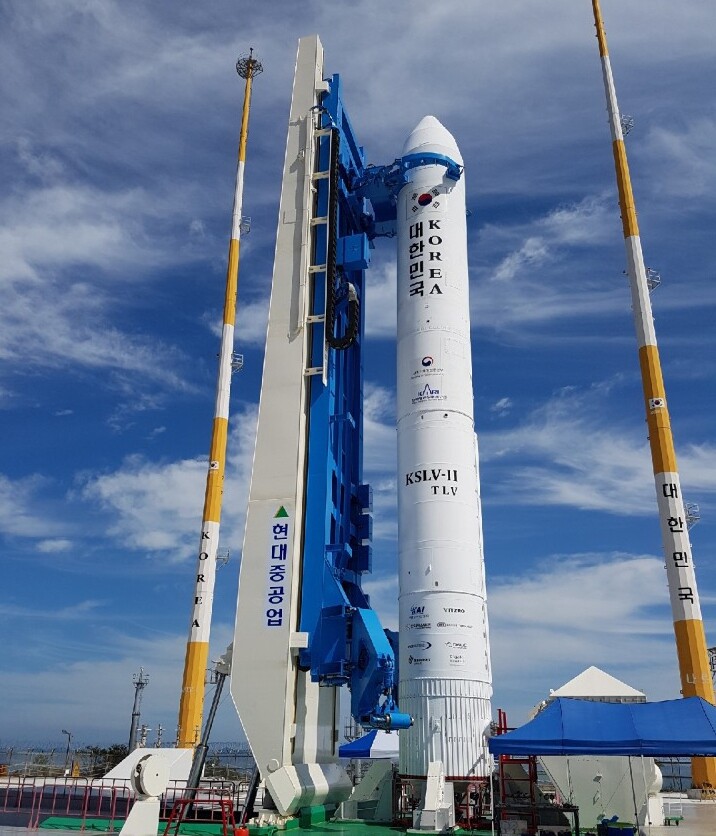hankyoreh
Links to other country sites 다른 나라 사이트 링크
US in discussions to allow S. Korea to develop civilian solid-propellant launch vehicles

South Korea and the US are holding discussions on amending their missile guidelines to allow South Korea’s development of civilian solid-propellant launch vehicles, the Ministry of Foreign Affairs (MOFA) announced on Nov. 12.
“Discussions are under way between South Korea and the US in connection with removing restrictions on the use of solid propellants for launch vehicles in order to strengthen space development capabilities in the private sector,” MOFA said in its announcement.
“The US position has not [yet] been clearly communicated to us,” the ministry added.
In a telephone conversation between South Korean President Moon Jae-in and US President Donald Trump on Sept. 4 of last year, the two leaders agreed on a third amendment lifting restrictions on South Korean missile warhead weights according to their missile guidelines; the new terms officially went into effect on Nov. 7. But a prohibition on the use of solid propellants in launch vehicles remained unchanged.
South Korea has consistently argued in the past that the missile guidelines should be altered to allow solid propellant use for civilian space launch vehicles. Both liquid and solid propellants can be used for rockets for space launch, but with solid propellants generating greater propulsion than liquid propellants, the use of solid propellants is closely tied to a nation’s space development capabilities.
The US has restricted South Korea’s use of solid propellants in their missile guidelines, citing the possibility of solid-propellant launch vehicles being diverted for intercontinental ballistic missile and other military uses. For that reason, the South Korea is currently using liquid propellant to develop its Naro and Nuri space launch vehicles, and is not developing any vehicles using solid propellant.
Potential for misunderstanding by North Korea, China and other neighbors
While the South Korean government said its discussions with the US on lifting the solid propellant restrictions were meant to “strengthen space development capabilities in the private sector,” its position is expected to generate some controversy due to the potential for misunderstanding by North Korea, China, and other neighbors.
“The likelihood of the US agreeing appears small,” said Shin Beom-cheol, director of the Asan Institute for Policy Studies security and unification center.
“The US has disallowed [solid propellant use] in the past due to concerns that South Korea might divert it toward long-range missile development. But the US position may have changed after discussions at the latest South Korea-US security cooperation meeting,” Shin said.
“Since this could have a detrimental effect on the North Korean denuclearization process, they will need to firmly pledge as a trust-building measures that this is for civilian development,” he added.
Kyungnam University Institute for Far Eastern Studies professor Kim Dong-yeop argued that Seoul is “going about things wrong.”
“The development of solid-propellant space launch vehicles is not actually a bad thing [in terms of improving space development capabilities],” he explained.
“But to prevent unnecessary misunderstandings from arising, we will need to openly explain why this is necessary and persuade the US side.”
The current South Korea-US missile guidelines were developed in 1979 for the transfer of missile technology from the US to South Korea. At the time, South Korea’s ballistic missile development capabilities were restricted to a maximum range of 180km and warhead weight of 500kg. An initial amendment in 2001 following North Korea’s 1998 launch of a long-range rocket (which it claimed was a satellite) increased the maximum range of South Korean missiles to 300 km; additional provisions stated that warhead weights could be increased if the range was reduced, but restricted the use of solid-propellant systems.
A second amendment under the Lee Myung-bak administration in 2012 increased the maximum missile range to 800km (for a 500-kg warhead). A third amendment under the Moon Jae-in administration resulted in restrictions on warhead weights being removed.
By Noh Ji-won, staff reporter
Please direct comments or questions to [english@hani.co.kr]

Editorial・opinion
![[Column] Has Korea, too, crossed the Rubicon on China? [Column] Has Korea, too, crossed the Rubicon on China?](https://flexible.img.hani.co.kr/flexible/normal/500/300/imgdb/original/2024/0419/9317135153409185.jpg) [Column] Has Korea, too, crossed the Rubicon on China?
[Column] Has Korea, too, crossed the Rubicon on China?![[Correspondent’s column] In Japan’s alliance with US, echoes of its past alliances with UK [Correspondent’s column] In Japan’s alliance with US, echoes of its past alliances with UK](https://flexible.img.hani.co.kr/flexible/normal/500/300/imgdb/original/2024/0419/2317135166563519.jpg) [Correspondent’s column] In Japan’s alliance with US, echoes of its past alliances with UK
[Correspondent’s column] In Japan’s alliance with US, echoes of its past alliances with UK- [Editorial] Does Yoon think the Korean public is wrong?
- [Editorial] As it bolsters its alliance with US, Japan must be accountable for past
- [Guest essay] Amending the Constitution is Yoon’s key to leaving office in public’s good graces
- [Editorial] 10 years on, lessons of Sewol tragedy must never be forgotten
- [Column] A death blow to Korea’s prosecutor politics
- [Correspondent’s column] The US and the end of Japanese pacifism
- [Guest essay] How Korea turned its trainee doctors into monsters
- [Guest essay] As someone who helped forge Seoul-Moscow ties, their status today troubles me
Most viewed articles
- 1[Column] The clock is ticking for Korea’s first lady
- 2Hong Se-hwa, voice for tolerance whose memoir of exile touched a chord, dies at 76
- 3[Column] Has Korea, too, crossed the Rubicon on China?
- 4After 2 months of delayed, denied medical care, Koreans worry worst may be yet to come
- 5[Correspondent’s column] In Japan’s alliance with US, echoes of its past alliances with UK
- 6US overtakes China as Korea’s top export market, prompting trade sanction jitters
- 7All eyes on Xiaomi after it pulls off EV that Apple couldn’t
- 8[Photo] Smile ambassador, you’re on camera
- 9Samsung barricades office as unionized workers strike for better conditions
- 10S. Korea “monitoring developments” after report of secret Chinese police station in Seoul